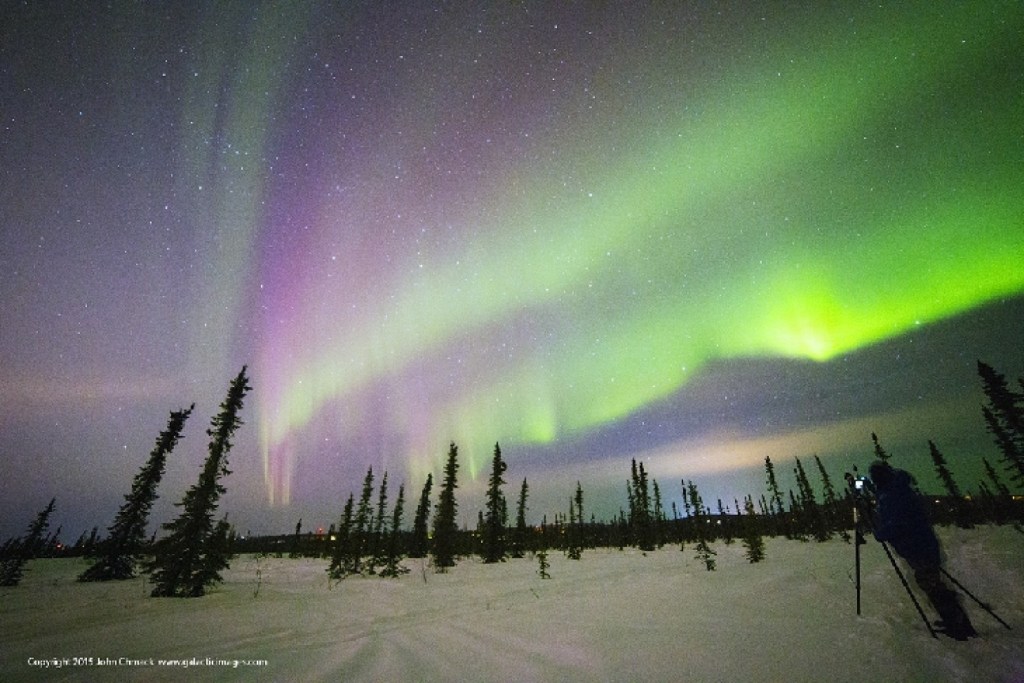WASHINGTON — A severe geomagnetic storm whipped through Earth’s magnetosphere on Tuesday, causing fluctuations on power grids and spawning a beautiful green, St. Patrick’s Day-themed aurora that stretched from the Arctic Circle to as far south as Oregon and Illinois.
The storm, which began late Monday, is among the strongest in the current 11-year solar cycle, earning a rating of a “severe” G4 on a one to five scale, which means it had the potential to affect power grids, high-frequency communications and satellite operations.
There were no reports of abnormalities or disconnections as of Tuesday afternoon and only minor voltage fluctuations. Interestingly, there was no radiation storm, which typically accompanies geomagnetic storms of this magnitude. Therefore, NOAA’s Space Weather Prediction Center was not expecting disruption to satellite electronics or polar-routed aviation.
But the changes in density in the ionosphere — the very high levels of Earth’s atmosphere — could cause more drag on low-orbit satellites, which operators may have to adjust for with thrusters. Simple GPS technology, like the kind in your car or on your smartphone, could be affected in the form of difficulties locating your position.
The solar wind was not particularly fast, but it was potent enough to cause the severe geomagnetic storm, according to Joe Kunches, director of space weather services at Atmospheric and Space Technology Associates.
The storm’s strength came as somewhat of a surprise to forecasters and was probably caused by the combination of two coronal mass ejections from an active sunspot region, forecasters at the prediction center said.
Space weather models predicted just a “glancing blow” from these ejections, which instead have caused a stronger disruption here on Earth, and vivid auroras.
Sunspots full of high magnetic energy frequently explode and send plumes of radiation called solar flares into space. When these flares and the super-heated plasma that can accompany them interact with Earth’s magnetic field, radioactive energy sometimes makes it into the Earth’s upper atmosphere.
These particles can interfere with radio communications and global positioning systems, and when strong enough, they can even harm the electrical grid. But they do have at least one positive effect: The impact of the particles with the upper atmosphere creates a beautiful glow that we know as the northern lights.
Because the Earth’s magnetic field funnels charged particles from these solar storms towards its poles, polar regions are much more likely to be affected by them. That’s why the auroras are most frequently seen at the poles and rarely make it to North America, as they have this week.
Solar cycles are periodic changes in the sun’s activity, including the number of sunspots and solar flares, that have an average duration of about 11 years. They are marked by solar maximums and minimums. The sun is currently close to the solar maximum of this cycle, which began on Jan. 4, 2008, and likely peaked in April 2014.
The Space Weather Prediction Center, part of the National Oceanic and Atmospheric Administration, ranks the intensity of geomagnetic storms on a G-scale of one to five, with five being the strongest. According to the center, on average around 100 G4-magnitude storms occur every solar cycle. This is the first G4 storm since the fall of 2013. There hasn’t been a G5 storm — the strongest on the scale — since August 2005.
The current storm is in season, so to speak, since they are most common around the equinoxes.
Research as to why solar storms are more common and severe around the equinoxes is still ongoing, but it most likely has to do with the way the Earth’s position relative to the sun changes. The Earth’s orientation changes what parts of its magnetic field are interacting with the sun’s, making those interactions more volatile.
Send questions/comments to the editors.



Success. Please wait for the page to reload. If the page does not reload within 5 seconds, please refresh the page.
Enter your email and password to access comments.
Hi, to comment on stories you must . This profile is in addition to your subscription and website login.
Already have a commenting profile? .
Invalid username/password.
Please check your email to confirm and complete your registration.
Only subscribers are eligible to post comments. Please subscribe or login first for digital access. Here’s why.
Use the form below to reset your password. When you've submitted your account email, we will send an email with a reset code.